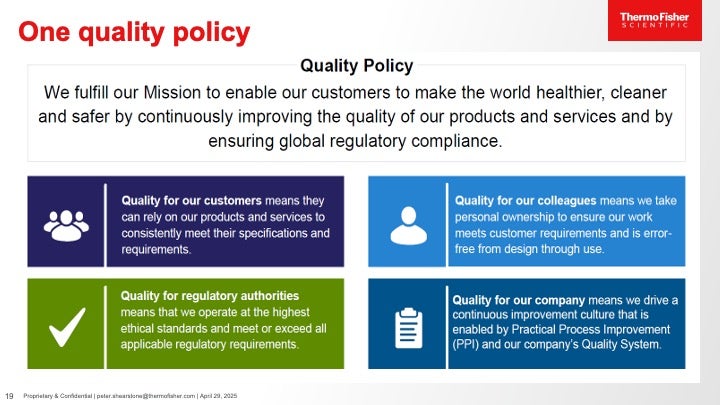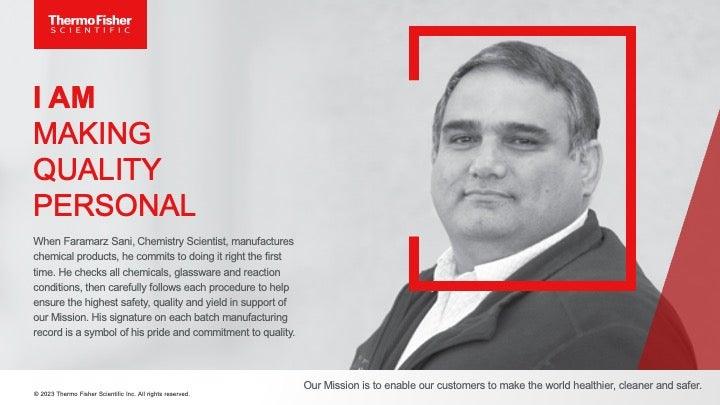Thermo Fisher Scientific: Enabling a Culture of Quality
Establishing and sustaining a culture of quality is essential for medtech companies to comply with regulatory requirements, deliver effective results, and ensure patient safety.
Peter Shearstone, vice president of global quality and regulatory affairs at Thermo Fisher Scientific, recently shared insights from the company’s multi-year effort to instill a culture of quality among its 125,000 employees.
Why a culture of quality matters
To Shearstone, the strategic function of quality and regulatory affairs (Q&RA) must be at the center of the business. Everything that a company does, whether it’s shipping a product, designing a product, or manufacturing a product, runs through quality. “We should be taken seriously and have a seat at the table. Without quality, we have nothing. When a customer takes our product out of the box, it had better work,” says Shearstone.
Shearstone recognized that enabling a culture of quality can be difficult with business pressures, deadlines, and meeting customer needs, but he outlined Thermo Fisher’s four-pronged strategy to build and sustain that culture.
One quality leadership team
To improve efficiency and create scale, Shearstone reorganized the nearly 9,000-person Q&RA function and established a small corporate team to standardize and harmonize the company quality policy, processes, technology, and process improvement efforts. He also meets with business unit quality leaders monthly to align priorities and share best practices.
One quality policy
When Shearstone took over, there were many different quality policies due to various acquisitions and divisions within the company. Today, Thermo Fisher follows one unified policy outlining what quality means to key stakeholders. With each acquisition, Thermo Fisher introduces its single company quality policy, enabling harmonization for key processes and technology. It also means that for customers of more than one of the company’s many businesses, they know there’s one quality standard they can depend on across all of Thermo Fisher.

One quality approach
Thermo Fisher landed on “making quality personal” (MQP) as a singular approach to instill a tangible, behavioral sense of quality that applied to every employee, no matter what they do or where they work. The MQP mindset provides core behaviors for employees to internalize the importance of quality through personal action and accountability. Integrating MQP into every location and level, content, training, and communications are central to its success.

One quality goal
Thermo Fisher introduced a single, company-wide quality expectation of all employees four years ago that remains embedded in the company’s strategic plans today: “Take personal ownership of quality, regulatory compliance, and customer satisfaction”. Each employee, from finance managers to chemistry scientists to training specialists, incorporates this goal into their personal annual goals and documents their efforts and progress. According to Shearstone, “You can’t ignore or take a pass on quality when it’s built into the fabric of the company. It’s a lifestyle, not just a marketing slogan,”.
Measuring quality to ensure success
Thermo Fisher uses competency assessments and Gemba practices – where all levels of management interact with frontline employees – to ensure team members understand and appreciate the meaning of quality. “In the factories, we have a whole tier board process tied to our PPI [Practical Process Improvement] business system and you see ‘making quality personal’ daily in those meetings,” says Shearstone.
As a KPI-driven company, Thermo Fisher relies on CAPAs to identify, investigate and resolve manufacturing issues. By standardizing CAPA metrics across the business, Shearstone can directly correlate cultural initiatives such as “making quality personal” to improvements in operational outcomes. Thermo Fisher selected Veeva Quality as one of three quality management system (QMS) technology platforms to support its efforts. The company’s businesses are migrating to one of three QMS options to harmonize tracking, reporting, and accountability. Standardization will offer myriad benefits to the company, including more Q&RA professionals that can be deployed to other parts of the company if there’s a need to surge talent around a project. It also helps open more career development opportunities and paths for its employees.
Finally, Shearstone recommends that leaders deeply understand quality issues and commit to a cultural transformation that touches the entire organization. Failure to do so can be both costly and detrimental to patients and HCPs. “We wake up every day thinking about the customer. I consider an employee’s personal guarantee of quality as valuable currency. If an individual identifies an issue and reports it, the management chain follows that process even when inconvenient or untimely. We want to do it right the first time,” Shearstone adds.
—
Visit Veeva Connect to watch Peter’s full presentation on enabling a culture of quality.